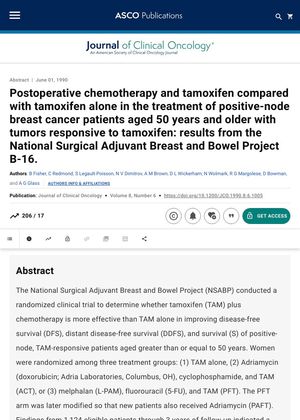Postoperative Chemotherapy and Tamoxifen Compared with Tamoxifen Alone in the Treatment of Positive-Node Breast Cancer Patients Aged 50 Years and Older with Tumors Responsive to Tamoxifen: Results from the National Surgical Adjuvant Breast and Bowel Project B-16
June 1990
in “
Journal of Clinical Oncology
”

TLDR Adding chemotherapy to tamoxifen improves survival for older breast cancer patients with positive nodes.
In a study conducted 33 years ago by the National Surgical Adjuvant Breast and Bowel Project, 1,124 positive-node, tamoxifen-responsive breast cancer patients aged 50 years and older were randomized to receive either tamoxifen alone, or tamoxifen plus chemotherapy. The results showed that patients treated with tamoxifen plus Adriamycin (doxorubicin), cyclophosphamide (ACT), or melphalan (L-PAM), fluorouracil (5-FU) (PFT) had significantly better disease-free survival (DFS) and distant disease-free survival (DDFS) rates than those treated with tamoxifen alone. Specifically, ACT-treated patients had a DFS of 84% compared to 67% for tamoxifen alone (P = .0004), and a DDFS of 83% compared to 73% (P = .04). Similarly, PFT-treated patients had a DFS of 81% compared to 72% (P = .07), and a DDFS of 85% compared to 74% (P = .02). The study concluded that postoperative prolonged tamoxifen and short-course AC therapy resulted in better outcomes than prolonged tamoxifen therapy alone for these patients.